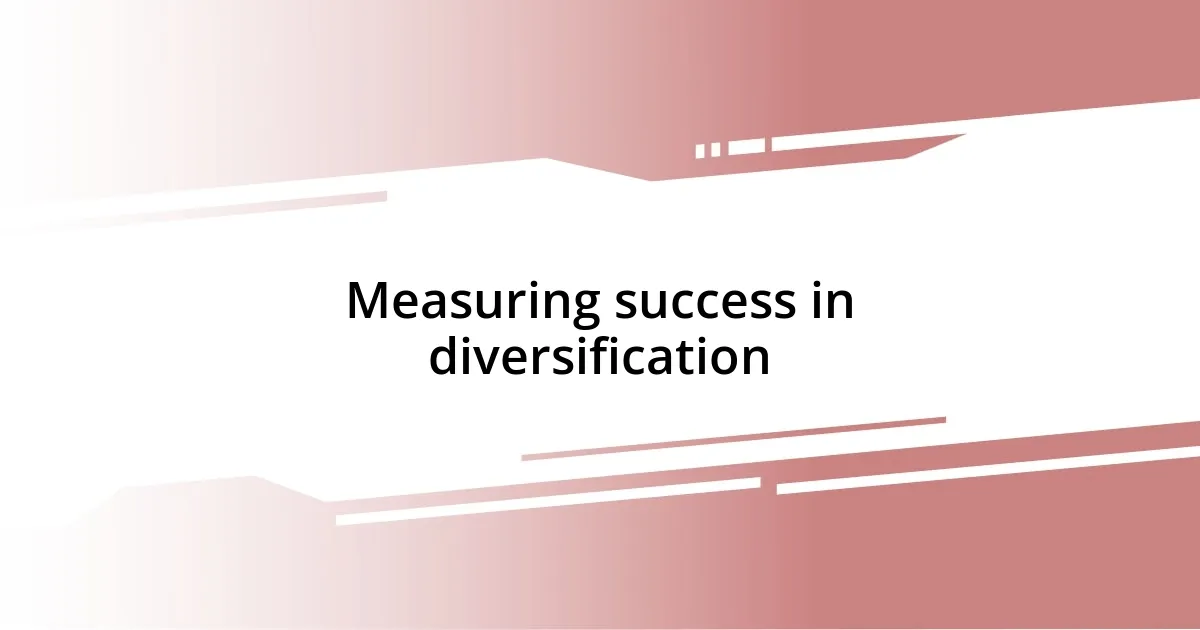Key takeaways:
- Diversification techniques involve spreading risk across various investments, such as stocks, bonds, and real estate, enhancing financial security.
- Common mistakes in diversification include spreading investments too thin, failing to rebalance, and relying heavily on one asset class.
- Future trends in diversification are expected to leverage technology (e.g., AI) and focus on sustainability and alternative assets.

Understanding diversification techniques
Diversification techniques are strategies aimed at spreading risk across different investments. I remember when I first learned about this concept; it felt like a light bulb moment. The idea that I didn’t have to put all my eggs in one basket was liberating. It encouraged me to explore various asset classes like stocks, bonds, and real estate, helping me feel more secure about my financial future.
One technique I’ve found particularly useful is asset allocation. This simply means dividing your portfolio into different categories based on your risk tolerance and investment goals. For instance, during market downturns, I’ve noticed that having a mix of high-risk and low-risk investments can buffer the impact. Have you ever felt that sinking feeling during a market dip? That’s when a well-allocated portfolio can save you a lot of heartache.
Another approach worth considering is sector diversification. It’s important to invest in different sectors to avoid being overly exposed to one area of the economy. For example, when tech stocks performed poorly a few years back, my investments in healthcare and consumer goods helped cushion my losses. Reflecting on that experience, I realized how crucial it is to diversify within sectors as well, giving me both peace of mind and better investment outcomes.

Benefits of diversification strategies
Diversification strategies offer a multitude of benefits that can significantly improve your investment experience. For instance, I recall a time when I was heavily invested in a single stock. When unexpected news hit that company, my heart sank as I watched my portfolio plummet. That experience taught me the vital lesson of risk management through diversification, allowing me to build a more resilient portfolio. By spreading investments across various assets, losses in one area can be offset by gains in another, leading to greater overall stability.
Here are some key benefits of adopting diversification strategies:
- Risk Reduction: By not relying on a single investment, you can minimize potential losses.
- Smoother Returns: A diversified portfolio often results in more consistent performance over time.
- Opportunities for Growth: Exposure to different sectors or asset types can open up new avenues for profit.
- Emotional Comfort: Knowing you’re protected from large swings in the market can lead to wiser decision-making.
- Long-term Planning: Diversification aligns well with various investment goals, enhancing the potential for steady growth.
Thinking about that single stock investment still gives me chills, but now, I approach my portfolio with a careful and balanced mindset, valuing the peace of mind that diversification brings.

Types of diversification explored
Understanding the varying types of diversification techniques can greatly enhance the strength of your investment portfolio. One of the simplest forms is geographic diversification. I dove into this strategy after hearing stories from friends who invested in international markets. By owning assets from different countries, I found that I could reduce the risk associated with economic downturns in my own country. Have you considered how global events can impact local markets? That realization prompted me to explore stocks from emerging markets, and it paid off as those investments surged during periods of U.S. economic uncertainty.
Investment type diversification is another technique worth recognizing. This involves holding a mix of asset classes, such as stocks, bonds, and real estate. I distinctly remember feeling hesitant about bonds because I associated them with lower returns. However, after allocating a portion of my portfolio to bonds during a market surge, I was pleasantly surprised at how they balanced my risk during volatility—from that moment, I recognized the value of a broader investment horizon. Have you ever had a realization about a type of investment that changed your perspective? For me, it was those bonds.
Lastly, I can’t overlook time diversification. This concept revolves around the practice of investing consistently over time, regardless of market conditions. I started using this method strategically by contributing to my retirement account each month, which not only transformed my savings but taught me the beauty of compounding returns. How often do you reflect on your investment habits? Embracing a long-term mindset has allowed me to ride out market fluctuations with confidence, building a steadily growing nest egg.
| Type of Diversification | Definition |
|---|---|
| Geographic Diversification | Investing across different countries to minimize risks associated with local economies. |
| Investment Type Diversification | Holding various asset classes, such as stocks, bonds, and real estate, to balance risk. |
| Time Diversification | Consistent investment over time, regardless of market conditions, to benefit from compounding returns. |

How to implement diversification
To effectively implement diversification, start by assessing your current portfolio and identifying any overexposure to certain assets. I remember the first time I looked at my investments and noticed that a majority were concentrated in technology stocks. It hit me like a ton of bricks—why was I putting all my eggs in one basket? By translating that concern into action, I made a deliberate move to explore other sectors like healthcare and consumer goods, which not only balanced my risk but also opened me up to new opportunities.
Once you identify areas to diversify, it’s crucial to research and select a mix of investments that align with your financial goals and risk tolerance. For instance, I often find myself diving deep into the fundamentals of potential stocks, looking for those that exhibit strong growth potential but are also backed by solid data. It’s a bit like detective work, isn’t it? By incorporating research into my investment decisions, I felt empowered to diversify across asset classes while being informed about what I owned.
Finally, consider automating your investment strategy. I started setting up automatic contributions to various asset types, which not only made my life easier but also took the emotional guessing game out of the process. Have you ever wrestled with when to invest? By automating my investments, I avoided the temptation of market timing and allowed my portfolio to grow steadily over time. Embracing this approach provided me peace of mind, knowing I was consistently working towards my financial goals without the stress of daily market fluctuations.

Common mistakes in diversification
When it comes to diversification, one common mistake is spreading investments too thin. I once tried to diversify by investing tiny amounts in a wide range of stocks, thinking I was being smart. Instead, I found it overwhelming and difficult to keep track of each investment. This often leads to a lack of focus, which can dilute potential gains. Have you ever felt lost in a sea of investments? That can happen when you don’t concentrate enough.
Another pitfall is failing to rebalance your portfolio over time. After I first diversified my investments, I got a bit lazy and didn’t check back in regularly. Some assets performed well while others lagged, causing the risk balance to shift silently. This was a rude awakening for me—if you don’t maintain your diversification, you might end up inadvertently becoming overly exposed to certain sectors or asset classes. How often do you revisit your portfolio? Ensuring a balanced approach can often mean the difference between moderate returns and substantial growth.
Finally, relying too much on just one type of asset class is a big mistake. I remember a time when I was overly reliant on cryptocurrency because of its hype. While it did yield temporary gains, an unexpected market dip left my portfolio in shambles. Diversification isn’t about avoiding risk entirely; it’s about managing and balancing it across different asset classes. Have you ever leaned too heavily into a ‘hot’ investment? Learning from these mistakes can help you build a more resilient portfolio going forward.

Measuring success in diversification
Measuring success in diversification can be as straightforward as analyzing the performance of your portfolio over time. I once had an eye-opening experience when I looked back at my diversified investments after a year. To my surprise, the sectors I had branched into were performing better than my original tech-heavy investments. It’s interesting how the right mix can often lead to more stability and growth. Have you ever tracked your portfolio’s performance post-diversification?
Another key metric to consider is the overall risk-adjusted return. This concept can sometimes feel a bit complex, but I like to think of it as a way to ensure that I’m not just chasing returns without understanding the risk involved. For example, after diversifying, I noticed that my portfolio’s volatility decreased, which made me feel more secure during market fluctuations. Assessing both returns and the risk taken to achieve them can help you understand true success in your diversification efforts.
Lastly, measuring how well your diversification strategy aligns with your financial goals is crucial. I remember clearly when I set specific targets for my portfolio—like retirement savings and emergency funds. Revisiting these goals helped me realize that my diversified investments were not only providing the growth I needed but also offered a safety net during uncertain times. Are your diversification efforts aligned with your personal financial aspirations? This alignment is often a strong indicator of success in the long run.

Future trends in diversification techniques
Future diversification techniques are likely to incorporate advanced technologies, such as artificial intelligence and machine learning, to analyze market patterns more effectively. I recently experimented with a robo-advisor that used AI to optimize my portfolio based on changing market conditions. It was fascinating to see how technology could continually assess risks and opportunities, prompting me to consider how much more efficient our decision-making processes could become in the future. Have you thought about how tech might empower your diversification strategy?
Another emerging trend is the emphasis on sustainability and ethical investing. I remember feeling a profound sense of fulfillment when I started investing in companies committed to environmental, social, and governance (ESG) factors. I found it invigorating to align my portfolio with my values while still diversifying my risk. As consumers become more conscientious, I believe this trend will drive investors to seek out opportunities that not only yield financial returns but also contribute positively to society. Do you see your values influencing your investment choices?
Finally, the rise of alternative assets is reshaping diversification strategies. In my own experience, I ventured into collectibles and real estate crowdfunding, which seemed unconventional but added a unique layer to my investment approach. This sector is growing, with many investors exploring assets beyond traditional stocks and bonds. It raises the question: Are you open to diversifying into areas that challenge the norm? As diversification techniques evolve, embracing alternatives could offer exciting prospects for building a well-rounded portfolio.














